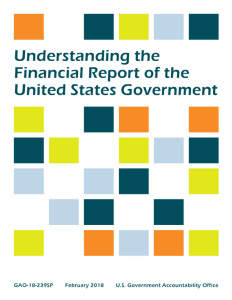U.S. Government’s Financial Report
 Making sense of the Financial Report
The annual Financial Report includes federal assets, debts, and major spending costs—e.g., for things like defense programs and Medicare—so it is fairly complicated, and can be difficult to understand.
Our new guide can help you decipher this report—check it out here, and in the video below, then read on for more on this year’s financial report.
Impediments to an audit opinion
We were unable to render an audit opinion—i.e., a conclusion on whether the financial statements are reliable—on the government’s fiscal year 2017 consolidated financial statements. Shortcomings that have plagued the financial statements in past years include:
Making sense of the Financial Report
The annual Financial Report includes federal assets, debts, and major spending costs—e.g., for things like defense programs and Medicare—so it is fairly complicated, and can be difficult to understand.
Our new guide can help you decipher this report—check it out here, and in the video below, then read on for more on this year’s financial report.
Impediments to an audit opinion
We were unable to render an audit opinion—i.e., a conclusion on whether the financial statements are reliable—on the government’s fiscal year 2017 consolidated financial statements. Shortcomings that have plagued the financial statements in past years include:
- Persistent problems with the Department of Defense’s financial management and auditability;
- The federal government’s inability to account for and reconcile certain transactions between federal entities; and
- An ineffective process for preparing the consolidated financial statements.
- Questions on the content of this post? Contact Dawn Simpson at SimpsonDB@gao.gov.
- Comments on GAO’s WatchBlog? Contact blog@gao.gov.

GAO's mission is to provide Congress with fact-based, nonpartisan information that can help improve federal government performance and ensure accountability for the benefit of the American people. GAO launched its WatchBlog in January, 2014, as part of its continuing effort to reach its audiences—Congress and the American people—where they are currently looking for information.
The blog format allows GAO to provide a little more context about its work than it can offer on its other social media platforms. Posts will tie GAO work to current events and the news; show how GAO’s work is affecting agencies or legislation; highlight reports, testimonies, and issue areas where GAO does work; and provide information about GAO itself, among other things.
Please send any feedback on GAO's WatchBlog to blog@gao.gov.
